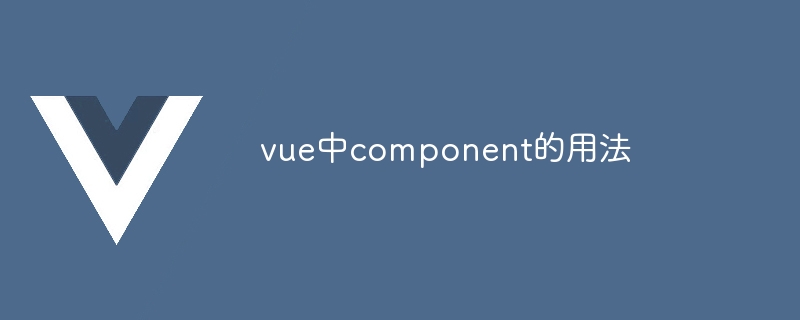Usage of component in vue
Vue Components Using Vue.js Components are a powerful feature that allow you to create reusable code blocks, separate templates and logic, and improve the modularity, maintainability, and testability of your application. . These benefits include: Reusability: Reduces the use of duplicate code Maintainability: Organizes related code to improve maintenance efficiency Modularity: Breaks the application into smaller modules to increase flexibility Separability: Separates templates and logic to improve maintainability Testability and flexibility

The use of components in Vue
Components are a powerful feature in Vue.js , which allows us to create reusable code blocks and use them throughout the application. This helps organize code, improve maintainability, and enhance application modularity.
Using Components
Creating components in Vue.js is very simple. Let's assume we have a component called MyButton:
Vue.component('MyButton', {
template: '<button @click="onClick">Click Me</button>',
methods: {
onClick() {
// 当按钮被点击时执行的代码
}
}
}); By using the Vue.component() method, we register MyButton components. Its template defines the component's HTML structure, and the methods object contains the component's logic and event handlers.
To use a component, just include it in another Vue instance:
<template> <MyButton /> </template>
This will render the MyButton component in the template. When the button is clicked, the onClick method will be called.
Advantages of Components
There are several major advantages to using components:
- Reusability:Components can Used multiple times, thus reducing duplicate code.
- Maintainability: Components organize related code together to make it easier to maintain.
- Modularization: Components allow us to break the application into smaller modules, thereby increasing its flexibility.
- Separability: Components allow us to separate templates and logic, thus improving testability and flexibility.
Other options
In addition to using the Vue.component() method, we can also use the following options to create and use components:
- Local components: These components are only available in the Vue instance in which they are created.
- Global Components: These components are available throughout the Vue application.
- Asynchronous components: These components can be loaded asynchronously.
All things considered, components are a powerful tool in Vue.js that can significantly improve the organization, maintainability, and modularity of your application.
The above is the detailed content of Usage of component in vue. For more information, please follow other related articles on the PHP Chinese website!

Hot AI Tools

Undresser.AI Undress
AI-powered app for creating realistic nude photos

AI Clothes Remover
Online AI tool for removing clothes from photos.

Undress AI Tool
Undress images for free

Clothoff.io
AI clothes remover

Video Face Swap
Swap faces in any video effortlessly with our completely free AI face swap tool!

Hot Article

Hot Tools

Notepad++7.3.1
Easy-to-use and free code editor

SublimeText3 Chinese version
Chinese version, very easy to use

Zend Studio 13.0.1
Powerful PHP integrated development environment

Dreamweaver CS6
Visual web development tools

SublimeText3 Mac version
God-level code editing software (SublimeText3)

Hot Topics
 1666
1666
 14
14
 1425
1425
 52
52
 1328
1328
 25
25
 1273
1273
 29
29
 1253
1253
 24
24
 How to use bootstrap in vue
Apr 07, 2025 pm 11:33 PM
How to use bootstrap in vue
Apr 07, 2025 pm 11:33 PM
Using Bootstrap in Vue.js is divided into five steps: Install Bootstrap. Import Bootstrap in main.js. Use the Bootstrap component directly in the template. Optional: Custom style. Optional: Use plug-ins.
 How to add functions to buttons for vue
Apr 08, 2025 am 08:51 AM
How to add functions to buttons for vue
Apr 08, 2025 am 08:51 AM
You can add a function to the Vue button by binding the button in the HTML template to a method. Define the method and write function logic in the Vue instance.
 How to use watch in vue
Apr 07, 2025 pm 11:36 PM
How to use watch in vue
Apr 07, 2025 pm 11:36 PM
The watch option in Vue.js allows developers to listen for changes in specific data. When the data changes, watch triggers a callback function to perform update views or other tasks. Its configuration options include immediate, which specifies whether to execute a callback immediately, and deep, which specifies whether to recursively listen to changes to objects or arrays.
 How to return to previous page by vue
Apr 07, 2025 pm 11:30 PM
How to return to previous page by vue
Apr 07, 2025 pm 11:30 PM
Vue.js has four methods to return to the previous page: $router.go(-1)$router.back() uses <router-link to="/" component window.history.back(), and the method selection depends on the scene.
 What does vue multi-page development mean?
Apr 07, 2025 pm 11:57 PM
What does vue multi-page development mean?
Apr 07, 2025 pm 11:57 PM
Vue multi-page development is a way to build applications using the Vue.js framework, where the application is divided into separate pages: Code Maintenance: Splitting the application into multiple pages can make the code easier to manage and maintain. Modularity: Each page can be used as a separate module for easy reuse and replacement. Simple routing: Navigation between pages can be managed through simple routing configuration. SEO Optimization: Each page has its own URL, which helps SEO.
 React vs. Vue: Which Framework Does Netflix Use?
Apr 14, 2025 am 12:19 AM
React vs. Vue: Which Framework Does Netflix Use?
Apr 14, 2025 am 12:19 AM
Netflixusesacustomframeworkcalled"Gibbon"builtonReact,notReactorVuedirectly.1)TeamExperience:Choosebasedonfamiliarity.2)ProjectComplexity:Vueforsimplerprojects,Reactforcomplexones.3)CustomizationNeeds:Reactoffersmoreflexibility.4)Ecosystema
 How to reference js file with vue.js
Apr 07, 2025 pm 11:27 PM
How to reference js file with vue.js
Apr 07, 2025 pm 11:27 PM
There are three ways to refer to JS files in Vue.js: directly specify the path using the <script> tag;; dynamic import using the mounted() lifecycle hook; and importing through the Vuex state management library.
 How to use vue traversal
Apr 07, 2025 pm 11:48 PM
How to use vue traversal
Apr 07, 2025 pm 11:48 PM
There are three common methods for Vue.js to traverse arrays and objects: the v-for directive is used to traverse each element and render templates; the v-bind directive can be used with v-for to dynamically set attribute values for each element; and the .map method can convert array elements into new arrays.




